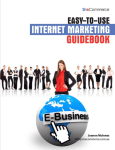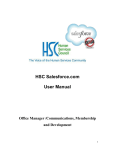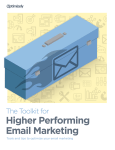Download Comparison of Email Service Providers 2012
Transcript
Comparison of Email Service Providers 2012 JANUARY 2012 Prepared by Sam Knox [email protected] 1402 3rd Avenue, Suite 1000 Seattle, Washington 98101 phone: 206-286-1235 fax: 206-260-2737 www.groundwire.org 0 ACKNOWLEDGEMENTS About the Author Sam Knox began his career at Groundwire in 2005. He has extensively documented many of the online tools used by Groundwire including the Plone Content Management System and Salesforce. He is now focused on delivering database and email communications consulting at Groundwire. Sam holds a bachelor's degree from the University of Washington's Program on the Environment, now known simply as the College of the Environment. He also holds a Certificate in Restoration Ecology, which makes him a certified plant nerd (in addition to being a technology nerd). About Groundwire Groundwire is a leading engagement nonprofit, focusing on both strategy and technology, for missiondriven organizations wanting to strengthen relationships with their audiences, and scale their impact. Groundwire provides strategy consulting, Salesforce.com implementation, and creates software and tools designed to measure and build audience engagement. For more information about this report, please contact: Sam Knox, Groundwire, 1402 Third Avenue, Suite 1000, Seattle, WA 98101; (206) 286-1235, [email protected] This report is licensed under a Creative Commons Attribution Non-Commercial Share Alike license. This means that you are free to share and remix this report, provided you recognize Groundwire as the source, preferably with a hyperlink, do not use the work for commercial purposes, and release your derivative work under the same or similar license. Important Disclaimer – The information contained in this report is as true and accurate as we could possibly make it. All information here is based on published information on each provider’s website or from direct communication with sales staff. Email Service Providers are constantly changing, so bear in mind that this report is only accurate as of January 2012, and you should always confirm information from the vendor before making a buying decision. www.groundwire.org 1 TABLE OF CONTENTS I. Introduction…………………………………………………………………………………………………………. 3 II. Summary………………………………………………..…………………………………………………………… 4 III. Price Comparison Table……………………………..……………………………………………………….. 5 IV. CampaignMonitor…………………………………..…………………………………………………………… 6 V. ConstantContact……………………………………………………………………………………………………. 8 VI. Emma…………………………………………………………………………………………………………………. 9 VII. Network for Good (powered by Emma)……………….……………………………………………….. 11 VIII. ExactTarget………………………………………………..…………………………………………………….. 12 IX. iContact…………………………………………………….……………………………………………….………. 14 X. JangoMail……………………………………………...……………………………………………………………. 16 XI. MailChimp…………………………………………...……………………………………………………………. 18 XII. PredictiveResponse…………………………….……………………………………………………………… 19 XIII. VerticalResponse……………………………………………………………………………………………… 21 XIV. WhatCounts……………………………………………………………………………………………………… 22 XV. Other Enterprise Providers………………………….………………………………………………………. 23 XVI. Other Small Business Providers………………….………………………………………………………. 26 VII. Salesforce Mass Email……………………………..…………………………………………………………. 27 www.groundwire.org 2 INTRODUCTION Navigating the wide array of Email Service Providers (ESPs) can be a daunting task as there are so many providers to choose from and a broad range of features and costs associated with those providers. Only some providers offer demo accounts to evaluate their service, and even then it can be difficult to uncover all of the nuances of the service until you are actively using it. This report is intended to provide a baseline of information on ESPs that we feel represent the best of breed, from the very small to the very large. Once you carefully consider your needs around email broadcasting you should be able to use this report to decide which service provider to evaluate first. To help you make a decision, here is a list of questions to consider. This list isn’t exhaustive, but these are things you should consider when evaluating vendors: • • • • • • • • What is your email send volume? What is your email list size? Do you require profile management? (a system for letting subscribers choose which lists they want to be on and update their contact info) Do you need Salesforce integration? What is your budget for email communications? Do you have someone (or several people) on staff who will manage your email communications effectively? Do you need to run a drip campaign? (an automated series of emails you can schedule and send to subscribers) Can you run what you need manually or do you need automation to run complex or repetitive tasks? You should not base your decision to adopt a service provider without doing a thorough analysis on your own or with the help of a consultant. www.groundwire.org 3 SUMMARY If you send a moderate amount of email, say 20,000 per month, you can expect to find providers ranging in cost from $29.95 to $2,000 per month and up. Most providers’ prices go down with volume, so sending at 40,000 emails per month doesn’t necessarily mean the cost will double. These prices represent a very wide range of features, integrations, and levels of service from Email Service Providers. One of the most important factors informing a decision to adopt a particular platform is whether or not you need database integration. Our report highlights which providers offer a Salesforce CRM integration and which do not (or offer only a limited one). ExactTarget, PredictiveResponse, iContact, and VerticalResponse offer strong Salesforce integrations while MailChimp, ConstantContact, Emma, and Network for Good offer very limited integrations. Integrations with other platforms (such as Drupal, Joomla, and CiviCRM) are mentioned also in this report. Another important consideration is the ease of use of the different platforms. Some assume a certain level of technical expertise and comfort with email broadcasting, while others strive to serve non-technical users. You will want to carefully consider the technical ability of your staff and the amount of time you have allotted for email communication. A single monthly newsletter often takes 4-6 staff hours or more to produce effectively. It can take even more time if you segment your lists, or perform A/B testing before sending to your list. Broadly speaking, services geared toward non-technical users are: • • • • • • • MailChimp CampaignMonitor iContact ConstantContact VerticalResponse Network for Good Emma Services geared toward more technical users are: • • • • WhatCounts ExactTarget JangoMail PredictiveResponse Why No Features Chart? You might wonder why you won’t find a chart comparing features in this report. The reason is because it’s very hard to compare apples-to-apples between different providers. There are often subtle but important differences in the way a feature performs which might make it undesirable for certain use cases or skill levels. We also feel that attempts to classify a feature as “good”, “bad” or “average” is a highly subjective endeavor. For those reasons, we have declined to provide a comparison checklist of features and instead would encourage you to spend time evaluating specific features on your own. It is only through experience that you can accurately appraise whether a feature will meet your needs or not. www.groundwire.org 4 Price Comparison Table One of the harder tasks to accomplish when comparing tools is doing a price comparison. Some providers base their prices on send volume; others base it on your list size and let you send as much email as you want. There are discounts for buying in bulk and discounts for nonprofits and benefit corporations (B Corp) as well. While you should always do your own analysis of price, here is a hypothetical situation so that we can compare across providers. Example: Your list size is 10,000 strong and you mail to it twice per month meaning your send volume is 20,000 emails per month. Prices shown are with nonprofit, B Corp, and pre-pay discounts where applicable. Provider Price per month (pay as you go) Network for Good $29.95 Price per year (some vendors offer discounts for pre-purchase) $360 iContact $50 $600 MailChimp1 $63.75 $765 ConstantContact1 $75 $630 VerticalResponse $102 $765 CampaignMonitor $100 $1,200 iContact for Salesforce $150 $1,800 Emma $168 $1,814 JangoMail $192 $2,304 WhatCounts Contact vendor or reseller for details Contact vendor or reseller for details Contact vendor or reseller for details Contact vendor or reseller for details Contact vendor or reseller for details Contact vendor or reseller for details Contact vendor or reseller for details Contact vendor or reseller for details ExactTarget Core PredictiveResponse ExactTarget Advanced 1: Unlimited send volume www.groundwire.org 5 EMAIL SERVICE PROVIDERS www.campaignmonitor.com DESCRIPTION The thing I like best about CampaignMonitor is the thoughtful research they do in the realm of email design and deliverability. CampaignMonitor is part of a wider initiative pushing for HTML standards in email. A lot of very useful information has come out of their effort to document exactly which email clients (Hotmail, Gmail, Outlook, etc) can interpret certain HTML or CSS elements. Clearly these guys understand the issues email marketers face. The platform itself offers a wide range of features and a nicely done user interface. Everything I wanted to test or explore was easy to find and labeled intuitively. There’s a nice template library available from which you can download pre-formatted source code, customize it, and upload your branded version. CampaignMonitor hits all of the essential points of a reliable email broadcasting tool and would be a great choice for a small organization sending less than 10,000 emails per month. I refer to CampaignMonitor all the time when I need to see what the latest trends are for HTML support in email clients, sender reputation and many other topics. If you live and work in email broadcasting a lot, you’ll find yourself on their website more than once. However, I found their actual platform documentation a little lacking. It’s all well-written but you have to hunt around a bit to find what you’re looking for. I’d really like to see these guys produce tutorial videos in the future. FEATURES In addition to the standard array of features found in most ESPs, some stand-out features from CampaignMonitor include: • • • • • • A/B split testing Autoresponders and Drip Campaigns Inbox preview (see screenshots of your email in 20+ inboxes) Open API A report that tells you which email client subscribers are using Spam reports Click here for a full list of features available on this platform. SALESFORCE INTEGRATION A third-party company called SNB Apps has created a Salesforce integration for CampaignMonitor. Some highlights are: www.groundwire.org 6 • • • • • Subscribers are added to lists via a list view. This is poor usability as you’re limited to selecting 200 Contacts at a time in a list view. We recommend that they use Campaigns as the integration point. Subscribers can be imported via CSV as generated from a Salesforce report Uses a custom objects for email stats. This often introduces data storage problems. Read our blog post about this issue. Email stats (including unsubscribes) must be manually refreshed. Not a huge deal but if you forget to do it, you’ll have bad data. The integration has its own blog: http://sfdccm.blogspot.com/ Read this page for more information about this integration from SNB Apps. OTHER INTEGRATIONS CampaignMonitor offers integrations with several Content Management Systems, CRM databases, and eCommerce providers. Here’s a select list of available integrations: • • • • • • • • WordPress Drupal Joomla Microsoft Dynamics CRM Tactile CRM Shopify Zen Cart Magento Click here for a full list of integrations available on this platform. PRICING CampaignMonitor offers monthly pricing (based on list size) along with pay-as-you-go. Pay-as-you-go • • $5 plus 1 cent per email (up to 50,000) Price per email drops to $0.0o8 above 50,000 email credits and gets cheaper as you increase volume Monthly Pricing Monthly pricing is probably the best deal going at CampaignMonitor. This is a new pricing structure and it’s welcome because volume sending now scales better. Here are the specifics: • • • Pricing is based on list size, not volume Cost ranges from $15 for up to 500 subscribers to $500 for up to 50,000 Send volume is unlimited www.groundwire.org 7 Even with the monthly plans, high volume sends aren’t cheap. The bottom line is that it’s fairly inexpensive when you’re doing low volume sending, but gets expensive quickly when you scale up. Also, there is no discount available for nonprofit organizations or benefit corporations. For complete pricing information on CampaignMonitor, visit their website. Another thing worth mentioning is that the company is based in Australia and you might have to pay international transaction fees depending on your bank or credit card provider. www.constantcontact.com Description ConstantContact has a very large client base or “market penetration” in the parlance of the business world. You've likely heard their advertisements on National Public Radio. ConstantContact is a great choice for organizations with no technical staff who need to broadcast a newsletter or announcements to their supporters quickly and easily. One strength of this provider is the large and easily customizable template library that they offer. Most users of this platform do just fine by choosing one of the available templates and adding their own branding to it. You can do quite a bit of customizing of the templates, but there really isn’t a global editing environment. For those of us who are used to using an HTML editor to edit all parts of the email at once, ConstantContact might not be the best choice. Added to that, we’ve noticed that the HTML ConstantContact writes in the background is bloated in terms of characters (really long URLs, long IDs, titles, etc). This creates large file sizes and makes troubleshooting very difficult. Self-guided learning resources abound on the ConstantContact website. They offer a nice array of tutorial videos and printed “how-to” instructions. Recorded webinars can be found on many topics as well. They also offer classroom-based workshops on a regular basis. All of this adds up to a strong showing in the support department. There’s a lot to like about ConstantContact but I’ve always felt that you could find a better platform for the same money. Both VerticalResponse and MailChimp offer the same level of functionality and better integration options and a more powerful template editor so I wouldn’t recommend it to organizations who need either of those things. Still, I know of many organizations without those needs who are happy using it. Features In addition to the standard array of features found in most ESPs, some stand-out features from ConstantContact include: • • Create, send and track online surveys Event registration, including paid events www.groundwire.org 8 • • • Partner/Affiliate program Open API Autoresponder emails Click here for complete information on ConstantContact’s features Salesforce Integration There is a limited Salesforce integration available, but it’s not much more than an automated export from Salesforce. Data does not flow back into Salesforce to track email metrics or even unsubscribes. Read the Groundwire blog post for more about the limitations of this integration. Other Integrations ConstantContact offers a development platform via their API others have produced integrations. Most notably, there is a Drupal module available now as well as an integration with CiviCRM. Pricing A big part of the success of ConstantContact can be attributed to their low prices. Also, the price is dependent on list size, not volume. You can send as much email as you want, as often as you want which is a very attractive offering. Discounts are also available for nonprofits and pre-purchasing. Here are some examples of price points: • • • • If your list size is 2,500 contacts, a month of service costs $21 If your list size is 5,000 contacts, a month of service costs $35 If your list size is 10,000 contacts, a month of service costs $52.50 If your lists size is 25,000 contacts, a month of service costs $105 Click here for complete pricing information on ConstantContact www.myemma.com Description Emma prides itself (herself?) on customer service. They have live chat, email and phone support. The website is very clear about how to get started and all information is presented clearly with some nice graphic design. The tone of Emma is very conversational and personal – a nice departure from buzzword-laden direct marketing speak present on most ESP websites. We liked a lot of what Emma had to offer. There's an open API, profile management, a large template layout library, and segmentation tools. They also offer Emma Agency for top down management of several accounts. Emma is definitely on our list of favorites. www.groundwire.org 9 The interface is much improved from when I last reviewed the platform. Operations are clearly and cleanly displayed – they’ve obviously invested in user experience testing and I think it’s paid off. To design emails you build stationary (much like Letterhead for Salesforce users) and then choose from a few dozen layouts. The system reminds me a bit of how ConstantContact works. You can’t edit or rearrange every aspect of the template but for non-technical that’s actually a good thing. You can also upload your own custom HTML, but the uploader is very picky. Your code must pass some validation to successfully upload which is confusing since email rendering has no broadly accepted standards (so forcing you to standardize your code seems pointless to me). Also once you’ve uploaded your custom code, you can't then use their editor. So you either must use their stationary system or upload totally read-to-send HTML. I should also mention that Emma is committed to the success of mission-based organizations which are honored in their Emma 25 award. They choose 25 deserving organizations each year and grant them lifetime use of their platform for free. Way to go Emma! Click here to see the 2011 honorees. Features In addition to the standard array of features found in most ESPs, Emma also offers: • • • • • • • • Unlimited image storage File storage Surveys Web forms (for event registration, feedback, etc.) Social media sharing options Segmentation by subscriber data and behaviors Triggered emails API Emma also gives you a sneak-peak at new features. Read about them here on Featurepalooza. Salesforce Integration Yes, but very limited. You can import contacts from Salesforce Campaigns to Emma but it’s only a oneway integration. However, it appears that they may be on the verge of releasing a true two-way integration. Other Integrations I didn’t see any other integrations mentioned on the Emma website but their API is a rather new feature so I wouldn’t be surprised to see more integrations in the coming months. Pricing Pricing in monthly, or you can sign an annual contract to get a 10% discount. Here’s the price breakdown: • • 5,000 emails per month is $56 7,500 emails per month is $80 www.groundwire.org 10 • • • 10,000 emails per month is $100 25,000 emails per month is $168 50,000 emails per month is $280 Nonprofits get a 20% discount, but no discounts are available for benefit corporations other than the standard 10% for a year contract. Also, if you are a nonprofit you should look at getting Emma through Network for Good. Click here for a full listing of prices from Emma. Network for Good (powered by Emma) Description Network for Good scrapped their old email blasting platform and worked a deal with Emma to offer their platform at a highly reduced cost for nonprofits. So if you use the Network for Good’s “EmailNow” offering, you’re essentially using Emma. I’ve been a longtime fan of the Emma platform because of its approachability, nice graphic design, and user experience. Emma is priced fairly well for nonprofits, but within Network for Good it’s actually one of the least expensive options on the market I’ve found. Broadly speaking this platform offers much the same experience as many others described in this document. For a small-to-medium sized organization on a budget, this is a very attractive offering. There aren’t any features that are totally unique to Network for Good / Emma, although they are certainly presented very nicely. The strength of this platform rests more on the fact that they can design email templates for you (for a small cost) and the high touch and personable support staff. The pricing structure is very attractive as well. Network for Good also offers a donation processing service called DonateNow, which includes a simple integration with EmailNow. Features • • • • • 39 template layouts for free Social media sharing (track content sharing via social networks) Triggered emails (based on a date) Surveys Archive online version of every email Click here for information on Network for Good’s EmailNow features www.groundwire.org 11 Salesforce Integration Yes, but very limited. You can import contacts from Salesforce into EmailNow but it’s only a one-way integration. Read this article on Emma’s website for more info. Other Integrations Network for Good doesn’t explicitly offer many integrations but they do offer developers a chance to build their own integrations. Pricing As stated above, the retail price of Emma is vastly reduced if you become a customer of Network for Good. Your organization must be a registered 501(c)3 to receive this discount. Here are the pricing details: • • • • • Send up to 20,000 emails per month for $29.95 Over 20,000 emails per month costs $2 per thousand emails Example: 40,000 emails per month would cost $70 Custom designed template for $99 One-time account setup costs $49 Click here to view complete pricing details for Network for Good www.exacttarget.com Description ExactTarget is an amazing toolkit for building a very sophisticated email broadcasting program. Here at Groundwire we got really excited when we learned about this platform and its nearly seamless integration with Salesforce. Users of VerticalResponse know that it’s frustrating to have separate user accounts where images and drafts can’t be shared and all unsubscribes are treated as global (you can’t unsubscribe from just one list). With ExactTarget, both of those problems are solved. The best fit for this platform is large volume senders (20,000 per month or more) and/or who need Salesforce integration. ExactTarget handles email blasting expertly, but that’s just where the feature set begins. You can dynamically populate sections of your template based on subscriber details, even pull content from your website directly into your email. You can set up automated “drip campaigns”, triggered emails, custom landing pages, and conversion tracking. One caveat to all that is that their platform is very “modular” and you often will have to pay more money for more features. Contracts are annual so you also have to be prepared to purchase a year’s worth of service. This platform definitely has a steeper learning curve than most Email Service Providers. It makes sense though because the power at your fingertips is proportionally larger as well. Expect to spend a fair amount of time learning and by all means elect someone in your organization to be the resident “guru” in your www.groundwire.org 12 organization. Also expect to pay consultants if you want to leverage the higher end features, some of which require API programming. Despite the complexity, ExactTarget has one of the best documentation and training resources I’ve seen. There are scores of tutorial videos, how-to documents, a user community, and responsive technical support. The documentation resources are weighted towards their standalone application so Salesforce related information can be hard to find. Most customer service reps have a very limited understanding of Salesforce as well. Also, ExactTarget recently released a new user interface called the Interactive Marketing Hub (IMH) which looks really cool. Imagine being able to track your email, SMS messages, and tweets in one central location with calendaring and real-time stats. Take a look at the IMH website for more information. Features ExactTarget gives you a very big toolkit with which to build almost any workflow or automation you can imagine, provided you buy the necessary add-ons. Even additional user accounts cost money. All that aside, here’s a list of some of the most interesting features available on this platform: • • • • • • • • • Dynamic content Profile management Social media sharing (post email content on social networking sites) Twitter integration Triggered email Automated interactions (drip campaigns, custom workflows, etc) Private sending IP address API access SMS email capture and messaging Click here to explore the ExactTarget feature set and different service tiers. Salesforce Integration There’s much to like about the Salesforce integration that ExactTarget has to offer. Email stats populate automatically in near real time. You can mail to a Campaign, Report or a combination of both. However, there are two areas which we feel could be improved upon: • • From addresses are tied to user accounts. If you have 5 users, you only can send from 5 email addresses. They offer a service called Reply Mail Management which allows you to set a different From address, but you must pay for this service. Email statistics are tracked in two custom Salesforce objects and we have seen that this can cause data storage to balloon very quickly. There are strategies for limiting this growth, but we’d like to see ExactTarget use the Campaign Member object to store individual email results. Read more about this issue on our blog. The integration package is now almost 6 years old and it really shows. We’d like to see ExactTarget invest some time in updating this integration. AppExchange Score: 3.8 out of 5 (79 reviews) www.groundwire.org 13 Other Integrations ExactTarget advertises several major integrations you can take advantage of. They are: • • • • • Microsoft Dynamics CRM Google Analytics connector Webtrends Coremetrics Omniture Click here to read more about the integrations offered by ExactTarget. ExactTarget also offers Data Integration Services for helping you build a custom integration for your business processes. Pricing Contact ExactTarget for pricing or check with resellers of ExactTarget for discounted rates. www.icontact.com | www.icontactplus.com/salesforce Description iContact is a slick and well-presented email broadcasting tool. Their intro video is one of the best I’ve seen, touching on all the most salient points you want to see when evaluating a new platform. Their autoresponder feature is great to see, and not many offer this kind of functionality without additional cost. Probably the best fit for this tool is a typical small-to-medium sized organization. It’s probably one of the best entry-level offerings on the market today. You get a very intuitive interface, a great set of basic features along with a couple of more advanced ones like autoresponders, all for a very low price. iContact’s cousin iContactPlus offers a Salesforce integration, although the cost per month for using this integration is higher than the standalone version. There’s a lot we like about the integration especially now that you can access an HTML editor. The lack of one was a major drawback but iContact has stepped up and the Salesforce integration is more attractive than ever. Features In addition to the basic set of features offered by all ESPs, iContact distinguishes itself by offering these exciting features: • • Profile management Autoresponders (automated messages sent when a new subscriber is added to your list) www.groundwire.org 14 • • • • • Targeted sends RSS (create messages from inbound RSS feed) iPhone and iPod Touch app Surveys Spam scoring Click here for a full listing of iContact’s features Salesforce Integration The Salesforce integration is offered through what they call iContactPlus. Here are the pros and cons of this integration: Features • • • • • • Now includes access to an HTML editor – a major plus for non-technical users! Each campaign has fields for "success criteria" – you can set thresholds of clicks and opens for success. Arbitrary from addresses (some other platforms charge money for this) Send process is a single screen, not multi-page wizard Aggregate stats are stored in "iContact Sent Message Detail" custom object Can also create a Targeted Send - You can send follow up messages to people who have opened, clicked, opened but not clicked, etc. This is not automated but it does make it easier to pin point types of responders versus having to create reports Drawbacks • • • Unsubscribes are global – no profile management Stats must be updated manually Individual tracking results are stored in an "iContact Message Statistic" custom object. These custom objects tend to overload your Salesforce data storage quickly. AppExchange Score: 4.7 out of 5 (79 reviews) Other Integrations iContact offers a couple of other integrations including: • • • • • Twitter iPhone, iPod and Andriod apps WordPress Drupal Joomla Click here to read more about integrations available from iContact. www.groundwire.org 15 Pricing The iContact website publishes a basic price list and bases cost on your list size. You can send up to 6 times your list size in one month (so if your list is 5,000 you can send up to 30,000 emails per month). Here are a few price points to consider: • • • If your list size is 5,000 subscribers, the cost per month is $31.96 If your list size is 10,000 subscribers, the cost per month is $50.32 If your list size is 25,000 subscribers, the cost per month is $101.32 These prices assume a full year of service, plus the 20% nonprofit discount. Benefit corporations are also eligible for the 20% discount. Click here for a full list of iContact price options Salesforce Pricing There is a different price structure if you’re going to use iContact integrated with Salesforce. It’s based on send volume not list size. iContact doesn’t publish their Salesforce prices on their website, but here is what they told us when we inquired in June 2010: • • • • • Up to 10,000 messages per month for $79/mo Up to 25,000 messages per month for $150/mo Up to 50,000 messages per month for $250/mo Up to 100,000 messages per month for $400/mo Up to 250,000 messages per month for $750/mo There is a 20% discount available to nonprofits for Salesforce pricing as well as 10% for an annual contract for a total of 30%. https://www.jangomail.com/ Description JangoMail is a tale of two platforms. One the one hand they offer an amazing array of features and integration possibilities but on the other there’s a lot to be desired in terms of user experience. When I reviewed JangoMail I was immediately stuck at how unpolished the overall design of the tool was. It felt more like being in a programming environment than a finished product (you can see server log info right alongside your open rate for example). During testing I was slowed down by the overuse of pop-up windows and Java applications which need to run to use certain aspects of the platform. www.groundwire.org 16 However, if you can look past the lackluster UI design and general quirkiness of the platform you’ll find a wealth of features available to you, especially if you are technically minded. For example, if you’re putting a list together based on a complex set of criteria they offer a SQL query composition box alongside more traditional menu-based criteria selection. If you care about character encoding, web service API, HTTP headers and other techie tidbits then you’ll probably love JangoMail. Want to write VisualBasic to handle personalization logic? JangoMail is there for you. JangoMail aims high and in fact succeeds in what is really a powerful platform. If you’ve been in charge of email communications for some time and feel limited by what other platforms offer, then consider evaluating this one. The creators of JangoMail clearly understand the mass email sector and the technical infrastructure which powers it, but their platform struggles to translate that depth for the everyday email marketing user. Features Here is a short list of JangoMail features. Visit their website for a description of these and other features. • • • • • • • • • Spam Assassin-powered spam checking RSS-to-email Behavioral segmentation Reply mail management Triggered and recurring sends Dynamic content logic (if you know VisualBasic!) Email volume throttling Scheduled sends Surveys Click here for a complete listing of JangoMail features Salesforce Integration The Salesforce integration is simple and workable. The entire JangoMail application is iframed into Salesforce much like VerticalResponse and a few other platforms are. You can send email to a Lead, Contact, Campaign, or a list of Leads and Contacts from a list view. Then you decide what fields you want to export to JangoMail for use in merges, compose your email content, and send. The integration has been around since 2008 and could use an update. Some of the techniques used are now out-of-date such as S-controls instead of Visualforce pages. One apparent downside is that it doesn’t appear that you can run reports on JangoMail stats from within Salesforce. Stats only appear on Leads and Contacts in a custom S-control. AppExchange Score: 5 out of 5 (4 reviews) Other Integrations JangoMail supports integration not only with Salesforce but other data repositories. For example, you can synchronize your local Access database with JangoMail or a web-hosted version if you wish. For more on database integration option, read this page on their website. www.groundwire.org 17 Pricing JangoMail is feature rich with a price tag to match. Terms are month-to-month with email volume the main driver of price. Here are a couple of price points from their published price sheet: • • • $40 for up to 5,000 emails per month $80 for up to 12,000 emails per month $192 for up to 30,000 emails per month All features of the platform are included in these prices. Nonprofits can receive a 20% discount if they sign up for a year of service (prices above reflect this), or 15% for a shorter commitment. Click here for complete JangoMail price information www.mailchimp.com Description MailChimp continues to develop and improve their email platform since coming to the fore of the industry a few years ago. They’ve put a lot of polish on their user interface and offer a few features I haven’t seen anywhere else, including a bevy of mobile apps. This platform is probably one of the easiest to learn and has ranked very high among our staff at Groundwire in terms of the usability. The pricing is attractive to nonprofits large and small. MailChimp produces some great research and we at Groundwire applaud them in this effort. In the last year, they’ve released a host of reports on their website on such topics as: spam filters, marketing, and social media. Help documentation and videos are also easy to find and they have an active and responsive blog to mine through. I also appreciate how much thought they’ve put into workflow. You don’t have to bounce around the interface and find settings to do what you’re trying to do. They’ve done an admirable job of anticipating what configuration options you’re likely to want to set for a given process, and even if you forget a step somewhere you’re always returned to the exact stage in the process where you left off. Features This provider has piled on a number of very useful features over the last few years. Some of the highlights are: • • • • • RSS-to-email (automate email sends from an RSS feed) Dynamic Content (based on subscriber attributes) Autoresponders A/B testing Twitter Tracking (track tweets which refer to your campaigns) www.groundwire.org 18 • • • • Profile Management Golden Monkeys (track your most engaged subscribers on your smartphone) Many other mobile device apps API Click here for a full listing of all MailChimp features Salesforce Integration Only the MailChimp connector is currently available. According to their blog, a more robust integration is coming out but it is not available yet. The connector only lets you export subscribers from MailChimp to Salesforce not the other way around. We’d love to see the Chimp develop this out a little more. Other Integrations MailChimp offers a wide range of other integrations, although most of them are fairly light (i.e. web signup forms). A short list of interesting looking integrations are: • • • • • Facebook EventBrite FormSpring PayPal Drupal Click here for a full listing of MailChimp integrations Pricing Price for the Chimp ranges from free to based on list size, to pay-as-you-go. In a welcome move, they’ve increased the limits on their free account from last year. Also the Chimp now offers a 15% nonprofit discount. Here are a couple of price points based on the information on their website: • • • • • 2000 subscribers, up to 12,000 sends a month is free 2,500 subscribers costs $30/month (unlimited sends) 10,000 subscribers costs $75/month (unlimited sends) Purchase of 75,000 email credits costs $750 15% off for nonprofits Click here for a full listing of MailChimp price options www.predictiveresponse.com www.groundwire.org 19 Description PredictiveResponse is quietly becoming the most potent provider of Salesforce integrated mass email. We discovered them last year and have been totally impressed with their platform ever since. In fact, it’s one of the only platform specifically built to work directly with Salesforce from the ground up. They made all the right decisions in terms of how data storage works, the user interface, and feature set. We also really like how PredectiveResponse thinks of email communications. Everything in their platform is process driven and designed to adapt to how people respond to email. For example, an email campaign isn’t a single stage, but instead contains many stages such as: Sent – Not Opened, Opened – No Links Clicked, and Completed. At each stage you can choose to have a follow up email sent to the person based on which stage they are in. Another highlight of the system is the scoring feature. A score is a number assigned to each person which is an aggregation of their total activity in your campaigns. You can assign a numerical value to an open, click, or even a web page visit. These numbers are tallied up in Salesforce so that you can target your most active email subscribers. This system keeps bulky email activity data out of Salesforce so you won’t run up your data storage load nearly as fast as other integrations. If you need to know email metrics per person, the data can be accessed via the Predictive Response interface. In 2011, PredictiveResponse announced that they are rolling out a profile management system so subscribers can opt in and out of specific lists in your account instead of a global unsubscribe (very cool!). Another new feature is their A/B testing platform which is one of the best we’ve ever seen. All in all, PredictiveResponse ranks at the very top of our list. Features In addition to the standard ESP features, PredictiveResponse offers these powerful features: • • • • • • Profile management Drip campaigns Automatic addition of contacts to a campaign when certain criteria are met (a feature called Campaign Flow) Autoresponders Template and image storage library Powerful A/B testing Click here to read more about the features of PredictiveResponse Salesforce Integration Yes, it’s only available to Salesforce users. AppExchange Score: 4.9 out of 5 (17 reviews) Other Integrations This is a platform meant to work only with Salesforce. No other integrations currently exist, although there are plans in the works for a donation processing features. www.groundwire.org 20 Pricing Contact PredictiveResponse for pricing or check with resellers of PredictiveResponse for discounted rates. www.verticalresponse.com Description For the past few years VerticalResponse has been one of the most popular providers for mission-based organizations. The highlights are that VerticalResponse offers 10,000 free email credits for nonprofit in the US and charitable organizations in Canada. For many, this means they can run their email program at no cost. The other big highlight is the Salesforce integration, which is available with no additional fees. If you don’t use Salesforce, VerticalResponse is still a compelling offering. They’ve included a powerful segmentation feature to help you target your communications based on subscriber data or on interactions with previous email campaigns. A couple of limitations of VerticalResponse are worth pointing out here. Accounts have only one user, which means you have to share logins with each other to share access to the same account. This is particularly problematic for Salesforce users who are used to being able to share information easily. Also, all unsubscribes are treated as global, so even if you’re running multiple lists a subscriber will stop receiving all email from you if they unsubscribe. I think that true profile management is the most important new feature VerticalResponse could develop. VerticalResponse offers an easy to learn interface, a template library, and powerful visual editor all of which make this platform a great fit for organizations with little or no technical expertise. Add to that the Salesforce integration and free email sends and you have probably the best option for nonprofits today. Features In addition to the standard set of email broadcasting features, VerticalResponse offers: • • • • • Create and send physical postcards to your subscriber list Surveys Share emails on Facebook and Twitter Extensive template library 25MB of image storage Click here for a complete list of features from VerticalResponse Salesforce Integration For nonprofits the VerticalResponse integration in the most cost-effective way to get integrated email in Salesforce. The integration works very well. You simply populate a Campaign with your subscribers, craft www.groundwire.org 21 an email message in VerticalResponse and off you go. However there are a few drawbacks, most notably the lack of multiple list management. The integration package is over 6 years old. Salesforce has changed quite a bit since then and we’d like to see VerticalResponse invest time in updating their integration. AppExchange Score: 3.2 out of 5 (104 reviews) Other Integrations • • • Google Apps Google Analytics Intuit Workplace Click here for more information on available integrations Pricing As mentioned above, nonprofit organizations are eligible for 10,000 free email sends per month. Discounts are available for nonprofits that need to purchase more. Here’s the price breakdown: • • • 10,000 emails per month is free (nonprofits only) 10,000 additional emails per month is $64 20,000 additional emails per month is $128 Prices assume purchase of one year’s worth of email credits in advance Click here to see complete price details, including pricing on postcards www.whatcounts.com Description WhatCounts offers a host of powerful features that put it on par with other “enterprise” platforms. Profile management, dynamic content, pulling content directly from your website, suppression lists, polls, surveys, and blogging tools are all present. However, putting those features to use isn’t for the lighthearted. You need to invest time to learn how to use many of the features, and some basic operations are unusually difficult such as inserting images. Their 150 page user manual describes all the features in detail, and I recommend keeping it close at hand as you learn the platform. www.groundwire.org 22 Each year, WhatCounts releases updates to their platform and in recent year have added some cool features. Highlights are inbox preview, video media hosting, social media integrations and mobile device support. WhatCounts also offers a “broadcaster” service which essentially means that you can purchase a mail server. This kind of service is perfect for high-volume senders who need to guarantee mail delivery at very specific times of day, such as online magazines or other news service style organizations. Features In addition to the usual suite of platform features, WhatCounts also offers: • • • • • • • Profile management Dynamic content Social media sharing options Video hosting Approval workflow options Random segmentation for creating test groups Surveys Salesforce Integration WhatCounts recently released a revamped Salesforce integration. It’s a bit fussy to get it setup but once the initial configuration is established you’re set to go. You can manage your email templates and edit content by logging into WhatCounts or from within Salesforce. You can then select those templates for mailing from within Salesforce. Mailing lists can be created from Campaigns, Reports, or both. You can even select a Campaign to use as a suppression list to remove certain subscribers from the mailing. Statistics are tracked in one or more custom objects which means you’ll get detailed stats to report on in Salesforce but this may come at the cost of increased data storage. Other Integrations No other integrations are specifically mentioned on the WhatCounts website, though they do offer an API for custom programming. Pricing Contact WhatCounts for pricing or check with resellers of WhatCounts for discounted rates. Other Enterprise Providers Below are a few enterprise-level providers that we didn’t have time to analyze in depth but wanted to include in this report for comparison. We consider enterprise-level providers to offer multi-channel marketing, very high volume sending, and extensive feature sets especially in terms of automation. www.groundwire.org 23 Most of these providers’ strengths are in what is called lead management or lead nurturing and they offer powerful automation and analytic tools to support that. www.actonsoftware.com HIGHLIGHTS • • • • • • • • UI is polished and intended for non-technical staff Drip campaigns Lead scoring system for tracking aggregate engagement activity Multiple list and profile management Powerful automated segmentation based on profile and behavioral attributes Arbitrary from addresses supported (no additional fee) Price starts at $500 / month for up to 5,000 subscribers. Goes up to $750 / mo for up to 10,000 subscribers More details on ActOn pricing can be found here SALESFORCE INTEGRATION We got a demo of the integration and there’s a lot we liked about it. Most of the configuration and email send process is done directly in the ActOn interface (iframed into Salesforce) but your list information resides in Salesforce. We liked this approach because we have seen some providers try to create most of their email tools using Salesforce customizations which doesn’t always work very well (iContact tries this approach for example). AppExchange Score: 4.9 out of 5 (15 reviews) www.makesbridge.com HIGHLIGHTS • • • • • • Lots of sophisticated automation, but most of it isn’t available until you buy at the Pro level or above. Lead scoring (enterprise level and up) Triggered email alerts Multiple list management Pricing varies from $30/mo for 500 email sends up to $1,500 / mo for 50,000 email sends. More information on MakesBridge pricing can be found here. Additional email credits are comparatively expensive at $0.03 per email (that’s $150 for only 5000). Volume discounts are available. www.groundwire.org 24 • Online video demos are available here SALESFORCE INTEGRATION We didn’t demo this integration but from what we could tell from the demo videos it’s a good one. You can synchronize leads and contacts with MakesBridge on whatever schedule you want and you can see all your sending history within Salesforce. However, it does look like this integration creates records on leads and contacts for every send to track opens, clicks, etc. While this is great information to have in the database, this approach tends to eat up data storage very quickly. AppExchange Score: 4.9 out of 5 (29 reviews) www.marketo.com HIGHLIGHTS • • • • • • • There are three tiers of functionality: Small business, Professional, and Enterprise. Click here to see a comparison chart. Packages start at $1200/mo for up to 10,000 database contacts (Small business tier) Up to 100,000 contacts starts at $2,250 (Small business tier) Discounts available for non-profits Email send volume is unlimited Features common to all platforms include: o Drip campaigns o Triggered email o Advanced segmentation o Web activity tracking o Lead nurturing automation o Salesforce integration Watch a demo video of Marketo here SALESFORCE INTEGRATION According to the Appexchange entry, the integration doesn’t use any custom objects so that’s good news in terms of your data storage. We didn’t demo this tool so we can’t say much more than that. Contact Marketo directly for more information. AppExchange Score: 4.8 out of 5 (126 reviews) www.groundwire.org 25 http://www.eloqua.com/ HIGHLIGHTS • • • • • Unlimited send volume – pricing based on list size There are three platform tiers: Express, Team, and Enterprise. Click here for a comparison of features. Price starts at $2,000 per month for up to 10,000 contacts Features common to all tiers include: o Drip campaigns o Lead scoring o Lead nurturing o Website tracking o Microsites o Event marketing o Salesforce, Microsoft Dynamics, and Oracle CRM integration Click here for a video overview of Eloqua and lead management SALESFORCE INTEGRATION According to the AppExchange entry the integration uses three custom objects which might mean that email stats are stored in Salesforce. This tends to take up a lot of data storage over time and if you’re thinking about using this integration you should analyze the data storage load in detail. The integration package was released in 2005 and very likely is in need of an upgrade because of how much Salesforce has changed over time. AppExchange Score: 4.8 out of 5 (37 reviews) Other Small Business Providers There are literally dozens of providers aimed at small business email marketing. We don’t have direct experience with all of these, but here’s a short list of other popular providers you can look into if none of the above will meet your needs: • • • • • Aweber Benchmark Email Campaigner GraphicMail Mad Mimi www.groundwire.org 26 Providers in this space tend to offer very similar feature sets and roughly equivalent pricing structures. Choosing a favorite can come down to personal preference in terms of the user interface which is often the main differentiating factor. Salesforce Mass Email If you’re a regular Salesforce user, you probably know that Salesforce itself can send mass email without having to use a third-party integration. While this is true, there are some significant limitations to this feature. • • • Can only send up to 1,000 emails per day If you reach this limit, any automated email messages that are initiated by triggers or workflow will fail Information on email results is limited Our recommendation is not to use Salesforce Mass Email for regular broadcast email lists like a newsletter list or action alert list. You can use it for “transactional” style emails such as donor recognition, membership renewal notice, or other business related communications. 1402 Third Ave, Suite 1000, Seattle, WA 98101 p 206.286.1235 [email protected] Designed by www.groundwire.org 27










































